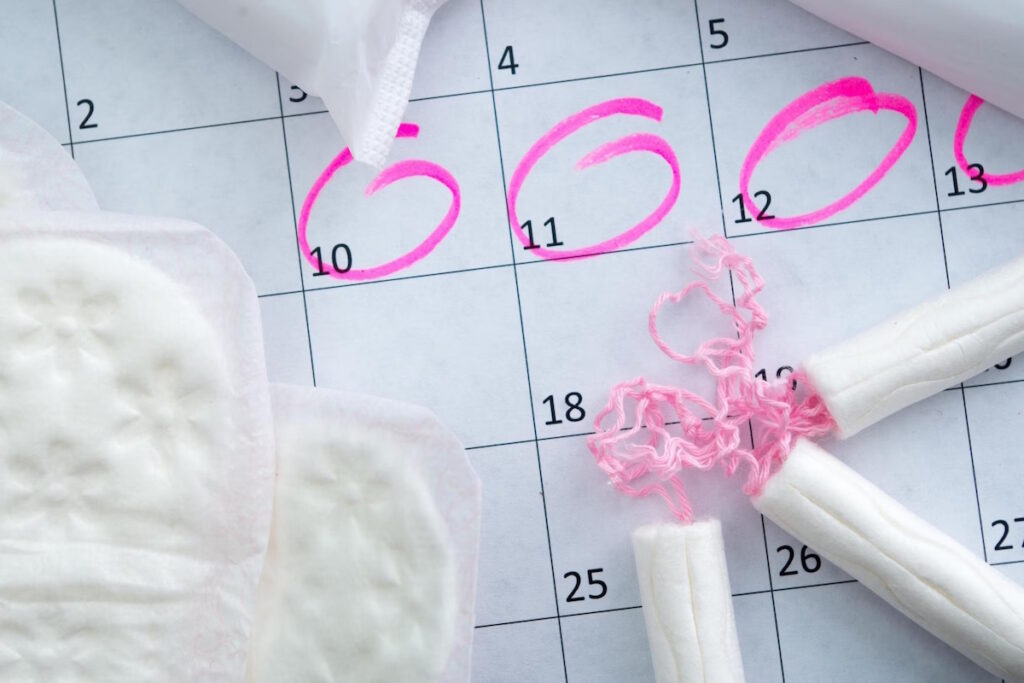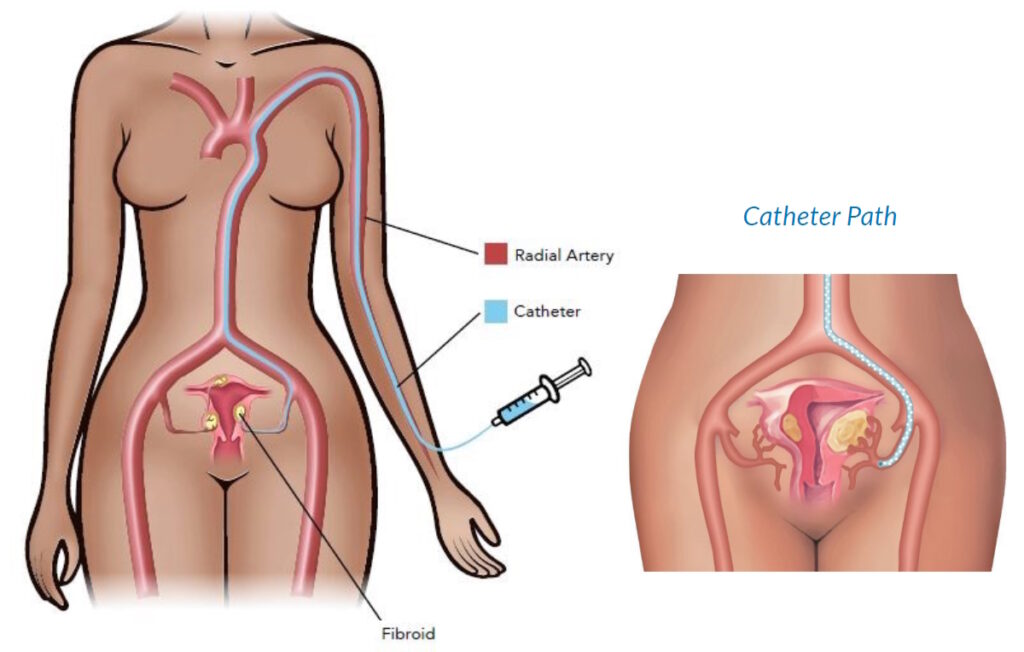Like many women Tiffanie* is constantly on the go. Whether she is working her way through a long list of appointments, getting a mountain of to-dos done at work, running errands, squeezing in a favor for a family member, or socializing with friends, her fast-paced life keeps her very busy. She has always enjoyed having that freedom and independence, which is why she knew she had to take charge of the heavy menstrual bleeding she had been experiencing for years due to unresolved uterine fibroids. Truth be told, Tiffanie thought this was her new normal after previous fibroid removal procedures didn’t work. This left her having to battle periods that lasted for so long and were so heavy that they occasionally bled through her clothes.
As a result, she searched for ways to increase protection and avoid embarrassment. In many instances, she debated not going anywhere and just staying inside the house. Thankfully, her gynecologist assured her that there was still hope and advised her to consider a hysterectomy or an alternative treatment known as Uterine Fibroid Embolization (UFE).
In her words, she was glad she chose the latter. “[UFE] is life-changing. You don’t have to be miserable and feel like you’ll bleed to death because of heavy periods,” she said. “My gynecologist told me about Fibroid Institute Texas; they were exactly what I hoped they’d be.”
Fast-forward to today and Tiffanie is pain-free and no longer deals with the embarrassment of heavy periods.
Fibroid Removal: ‘I Was Worried I Couldn’t Leave Home Without Having an Accident’
Each woman’s journey with fibroids is unique. That said, fibroid tumors are common. Researchers estimate that 70-80 percent of all women between the ages of 35 and 54 develop fibroids. Not all women with fibroids experience pain, but many do, and the symptoms are familiar across the board. One of them happens to be heavy menstrual bleeding. While cycles can be different for every woman, a normal menstrual flow lasts three to eight days and occurs every 22 to 38 days, with the menstrual cycle counted from the first day of one period to the first day of the next.

A “typical flow” is less than 80 ml of blood per menstrual cycle. That’s about the amount contained in a small Dixie cup. Anything more than that is considered heavy bleeding, as each soaked normal-sized tampon or pad holds a teaspoon (5 ml) of blood.
Tiffanie’s Fibroid Symptoms
Heavy menstrual bleeding
Periods lasting weeks at a time
Fatigue
About one-third of women seek treatment for heavy periods, which can include these symptoms:
- Heavier than normal bleeding or clotting
- Bleeding that causes pad changes every 1-2 hours
- Bleeding through your pads or the need to double up with a pad and a tampon
- Menstrual flow with blood clots that are as big as a quarter or larger
- Bleeding through your clothes or bedding
Sadly, Tiffanie checked all these boxes and more throughout her journey. Dealing with the constant threat of bleeding through her clothes was especially stressful and embarrassing. She even said that her heavy periods got to the point where she was worried that she couldn’t leave home without having an accident. To make matters worse, she had undergone two previous fibroid removal surgeries only to watch helplessly as those fibroids came back.
A “typical flow” is less than 80 ml of blood per menstrual cycle. That’s about the amount contained in a small Dixie cup. Anything more than that is considered heavy bleeding, as each soaked normal-sized tampon or pad holds a teaspoon (5 ml) of blood.
Believe it or not, fibroids can return. According to the Mayo Clinic, fibroids can reoccur in about 60% of women who have them. Granted, the likelihood depends on the procedure a woman undergoes, the patient’s age, and hormonal factors, but they can return. According to a myomectomy study, fibroids regrew within the first few years after the procedure in up to 20 out of 100 women. Furthermore, the University of California San Francisco states that the younger you are and the more fibroids you have at the time of your myomectomy procedure, the more likely you are to develop fibroids again in the future. While it is difficult to determine exactly why this can happen, reoccurrence may happen more with myomectomies because of the fact that it focuses solely on removing the existing fibroids while leaving the uterus intact. It does nothing to stop new ones from forming.
“It was really frustrating, and I knew it was time to get something done,” Tiffanie said. “My doctor told me to consider a hysterectomy, but that’s not what I wanted. The gynecologist then suggested UFE and Fibroid Institute, so I did my research, saw how other’s experiences were positive, and decided to try it.”
‘My Life Has Changed Dramatically’
It has been six months since Tiffanie opted to forgo fibroid removal and choose UFE as an effective fibroid treatment. She isn’t experiencing heavy menstrual bleeding anymore—she describes her periods today as “light and short, almost like they are not even there.” No more excessive bleeding. No more periods that last for days on end. As a result, she feels free and comfortable doing whatever she has going on daily.
She particularly marveled at Fibroid Institute’s Houston fibroid specialist Dr. John Fischer and his caring bedside manner.
“I would absolutely recommend Fibroid Institute and the UFE procedure to anyone who doesn’t want a hysterectomy and is a candidate for the procedure,” she said. “Fibroid Institute was right there to ensure I was OK after the procedure. They answered all my questions while I was there, and even after I left, I knew they were just a phone call away if I needed them. I felt well-supported the entire way.”
The message here is that you don’t have to suffer in silence with heavy menstrual bleeding and other telltale fibroid symptoms. Furthermore, surgery is not always the answer or your only option. That’s where UFE comes in.
Rather than remove fibroids, UFE shrinks them by inserting a small catheter by way of a small needle prick into the radial artery on the patient’s wrist. Experienced doctors at Fibroid Institute then advance it to the location of the targeted area and inject small particles to block blood flow to the fibroid tumors. This causes the fibroids to shrink and die.
This alternative way to eliminate fibroids also reduces the possibility of procedural pain to practically nil. Patients can expect an easy procedure performed while they are resting comfortably asleep. The procedure will last about one hour, and once you wake up, you will notice only a small bandage over the nick on your wrist.

Fibroid Institute Has a Solution To Your Heavy Menstrual Bleeding!
As Tiffanie’s case proves, gynecologists and patients alike trust our physicians and prefer the UFE procedure over traditional fibroid removal procedures such as myomectomy and hysterectomy. Our fibroid embolization specialists are not only compassionate and caring but also extremely knowledgeable. As a result, they are routinely invited to speak at medical conferences and physician education events nationwide. Why? We set the standard of care when it comes to advanced fibroid treatment and helping women achieve a fibroid-free life.
We specialize in UFE because it delivers results in the least amount of time and with limited to zero pain. On top of that, we simplify your UFE journey, managing everything from insurance to PCP communication and offering all patients physician-direct access before and after their procedure. With multiple locations, our fibroid centers in the Dallas and fibroid Houston areas help thousands of women avoid fibroid surgery and find relief from their fibroid symptoms. Our fibroid doctors are highly experienced UFE specialists, board-certified interventional radiologists, and experts passionate about helping women become #FibroidFree.
Request a free 10-15-minute phone screening to determine if you are eligible. If you qualify for UFE after the screening, you can schedule your on-site or telehealth consultation. Most major medical insurance providers cover the cost of UFE. Get started now with Fibroid Institute by calling Dallas fibroid clinics at 214-838-6440, Houston fibroid clinics at 713-903-3733, or complete the form below.
Prior to starting any new treatment or if you have questions regarding a medical condition, always seek the advice of your doctor or other qualified health provider. This information is not a substitute for professional medical advice.
Fibroid Institute Texas serves the Houston and Dallas metro areas including Houston, Sugar Land, Katy, Webster, Clear Lake, The Woodlands, Universal City, Spring, Kingwood, Stafford, Conroe, Texas City, Cypress, League City, Bellaire, Addison, Carrollton, Plano, Frisco, Craig Ranch, McKinney, Allen, Fort Worth, Grand Prairie, Hurst, Euless, Bedford, Arlington, Hutchins, Irving, Duncanville, DeSoto, Cedar Hill, Lancaster, Cockrell Hill, Highland Park, University Park, Park Cities, Garland, Mesquite, Richardson, Dallas, Sherman, and more.
*Patient names and/or photos may be changed to protect patient confidentiality.

